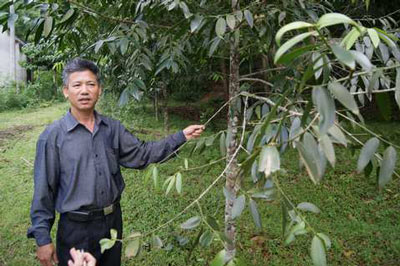Museum in the forest
That is Me Linh Biodiversity Station, established by the Institute of Ecology and Biological Resources to preserve native gene sources. Located on an area of more than 170 hectares, but the team "operating" the station only 8 people .
The place of nature
'A dozen kilometers away from the population, we often joked with each other, this is a "prison camp" . However, working here is comfortable, not dependent on hours like civil servants, 'said Dr. Le Dong Tan, Director of Me Linh Biodiversity Station.

Dr. Le Dong Tan introduced 88 species of plants to be planted in the station (Photo: H. Quan)
Exhibition silently
Dr. Tan said that when receiving a wider area of 170ha to establish a station in 1999, the area of artificial natural forests of this station was only planted with acacia trees and natural disasters."The station currently has more than 1,200 types of natural and artificial plants," said Dr. Tan.
The station's "ecosystem" now includes not only native plants, but also 88 species of plants across the country such as needles, grinds, milk, black stars, blooms, slices of flowers, yellow and yellow. , brown grass . Some native species of deer and turtles have been brought here by scientists. "The collection of animals at the station currently has only 11 species of turtles with more than 50 individuals and 8 deer. Turtle species such as the Central Turtle, the Big Land, the Four Eyes, the Golden Mountain, the Seson, and the Sage . In a natural and semi-natural environment for comparison, the station has only one part-time employee for feeding animals and monitoring their health , ' said Dr. Tan.
Most turtles are received from Soc Son Wildlife Rescue Center or from scientific studies, while deer are brought from the mountains of western Nghe An.

More than 300 orchid samples are labeled with numbers (Photo: H. Quan)
- 7 most horror museums in the world
- Arakan forest turtle was first discovered in the wild
- Strange feeling in the dark night at the museum
- Museum 800m2 on top of Chinese cliffs
- The most exotic trees on Earth
- Learn about the Louvre museum
- Promotion of the construction of the country's first science museum
- The 10 oldest forests on earth
- See the picturesque forest
- The world's most horrifying corpse museum in Mexico
- Building Vietnam Nature Museum
- Unique look of the underwater museum of Cancun
 Is the magnetic North Pole shift dangerous to humanity?
Is the magnetic North Pole shift dangerous to humanity? Washington legalizes the recycling of human bodies into fertilizer
Washington legalizes the recycling of human bodies into fertilizer Lightning stone - the mysterious guest
Lightning stone - the mysterious guest Stunned by the mysterious sunset, strange appearance
Stunned by the mysterious sunset, strange appearance